Sustainable Development Goal 5
Achieve gender equality and empower all women and girls
Sustainable Development Goal 5 is to “achieve gender equality and empower all women and girls”, according to the United Nations.
The visualizations and data below present the latest data on our progress there.
The UN has defined 9 targets and 14 indicators for SDG 5. Targets specify the goals and indicators represent the metrics by which the world aims to track whether these targets are achieved. Below we quote the original text of all targets and show the data on the agreed and some related indicators.
List of targets and indicators
Target 5.1End discrimination against women and girls
SDG Indicator 5.1.1Legal frameworks for gender equality and non-discrimination
Definition of the SDG indicator: Indicator 5.1.1 is “whether or not legal frameworks are in place to promote, enforce and monitor equality and non-discrimination on the basis of sex” in the UN SDG framework.
This indicator measures the extent to which countries have legal frameworks in place for gender equality in four areas: (i) overarching legal frameworks and public life; (ii) violence against women; (iii) employment and economic benefits; and (iv) marriage and family. Data for this indicator is shown in the first four charts in the series of interactive visualizations.
The other charts show related measures, including women’s right to vote.
Target: By 2030 “end all forms of discrimination against all women and girls everywhere.”
This requires legal frameworks in place to enforce gender equality for all countries.
More research: Further data and research on this topic can be found at the Our World in Data topic page on Women’s Rights.

Target 5.2End all violence against and exploitation of women and girls
SDG Indicator 5.2.1Violence against women from an intimate partner
Definition of the SDG indicator: Indicator 5.2.1 is the “proportion of ever-partnered women and girls aged 15 years and older subjected to physical, sexual or psychological violence by a current or former intimate partner in the previous 12 months, by form of violence and by age” in the UN SDG framework.
Data shown for this indicator is the share of ever-partnered women and girls aged 15 years or older who experienced physical or sexual violence from an intimate partner in the last year. Data related to psychological violence is not currently available.
Target: By 2030 “eliminate all forms of violence against all women and girls.”1
More research: Further data and research on this topic can be found at the Our World in Data topic page on Women’s Rights.

SDG Indicator 5.2.2Violence against women from persons other than an intimate partner
Definition of the SDG indicator: Indicator 5.2.2 is the “proportion of women and girls aged 15 years and older subjected to sexual violence by persons other than an intimate partner in the previous 12 months, by age and place of occurrence” in the UN SDG framework.
While some country-specific data exists, internationally comparable data is not yet available for this indicator.
Target: By 2030 “eliminate all forms of violence against all women and girls.”1
No data for this indicator
We are currently not aware of data for this indicator. You can notify us of available data for this indicator via our feedback form.
Target 5.3Eliminate forced marriages and genital mutilation
SDG Indicator 5.3.1Women married before age 15 or 18
Definition of the SDG indicator: Indicator 5.3.1 is the “proportion of women aged 20–24 years who were married or in a union before age 15 and before age 18” in the UN SDG framework.
Data for this indicator is shown in the interactive visualizations for women aged 20-24 years married by age 15 (first chart) and women aged 20-24 years married before age 18 (second chart).
Target: “Eliminate all harmful practices, such as child, early and forced marriage and female genital mutilation” by 2030.
More research: Further data and research on this topic can be found at the Our World in Data topic pages on Women’s Rights and Violence Against Children and Children’s Rights.
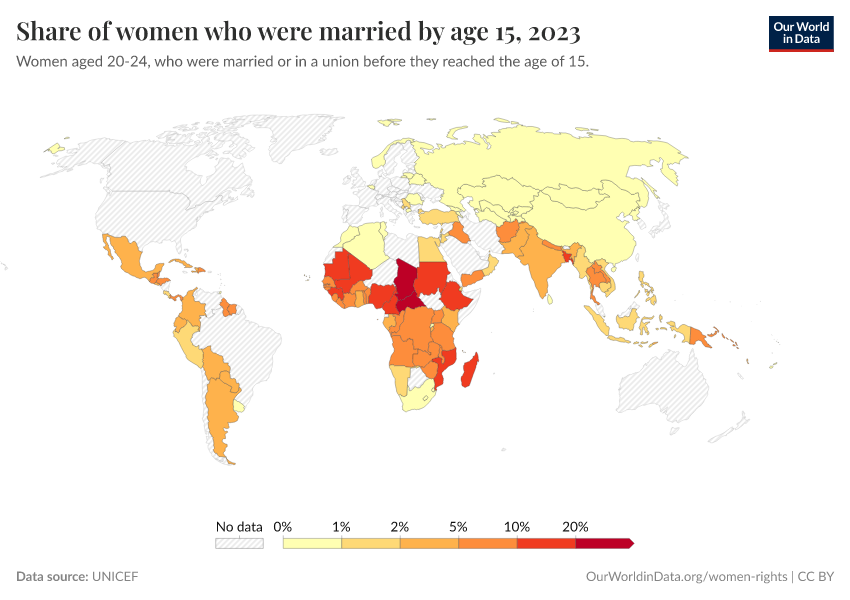
SDG Indicator 5.3.2Female genital mutilation/cutting
Definition of the SDG indicator: Indicator 5.3.2 is the “proportion of girls and women aged 15–49 years who have undergone female genital mutilation/cutting, by age” in the UN SDG framework.
This is measured as the share of women aged 15-49 years old who have gone through partial or total removal of the female external genitalia or other injury to the female genital organs for cultural or other non-therapeutic reasons.
Data for this indicator is shown in the interactive visualization.
Target: “Eliminate all harmful practices, such as child, early and forced marriage and female genital mutilation” by 2030.
More research: Further data and research on this topic can be found at the Our World in Data topic pages on Women’s Rights and Violence Against Children and Children’s Rights.
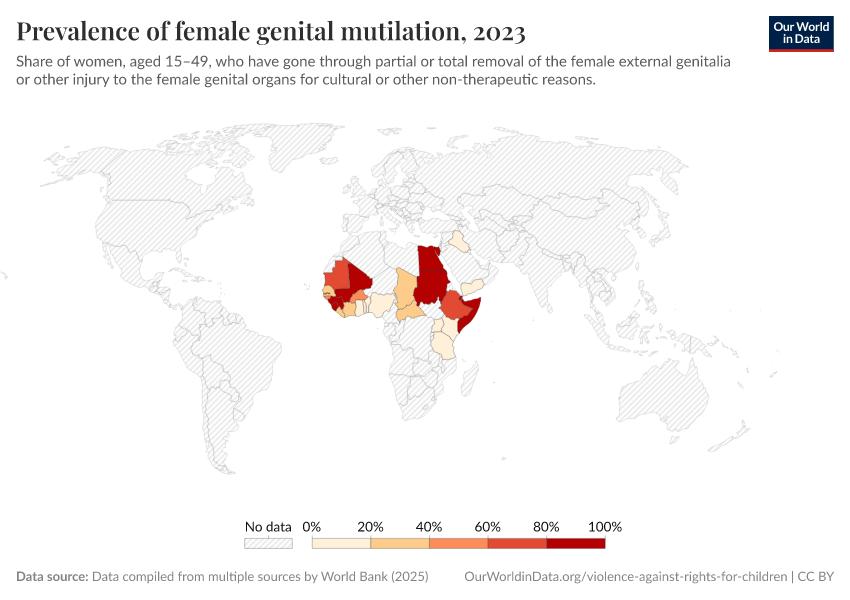
Target 5.4Value unpaid care and promote shared domestic responsibilities
SDG Indicator 5.4.1Time spent on unpaid domestic and care work
Definition of the SDG indicator: Indicator 5.4.1 is the “proportion of time spent on unpaid domestic and care work, by sex, age and location” in the UN SDG framework.
This is shown here in the interactive visualizations as the average share of the day men and women spend on unpaid domestic and care work (first chart), the time spent on unpaid care and domestic work by men and women in urban and rural areas (second chart), and the share of the day women spend on unpaid domestic and care work (third chart).
Target: By 2030 “recognize and value unpaid care and domestic work, and promote shared responsibility within the household and family.”2
More research: Further data and research on this topic can be found at the Our World in Data topic pages on Women’s Rights, Women's Employment and Working Hours.
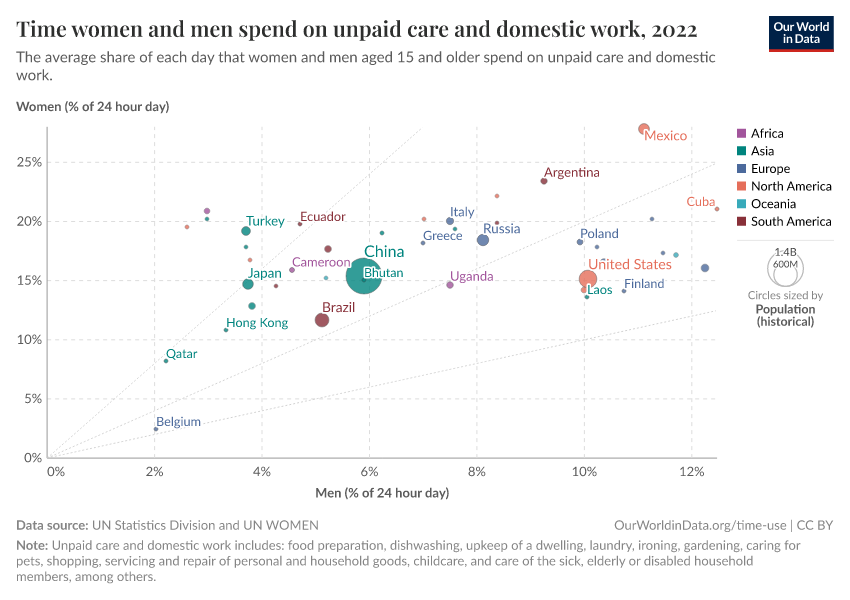
Target 5.5Ensure full participation in leadership and decision-making
SDG Indicator 5.5.1Women in political positions
Definition of the SDG indicator: Indicator 5.5.1 is the “proportion of seats held by women in (a) national parliaments and (b) local governments” in the UN SDG framework.
Data for this indicator is shown in the interactive visualizations for the share of parliamentary seats (first chart), elected seats in local government (second chart), and national ministerial positions (third chart) held by women in a given year.
Target: By 2030 “ensure women’s full and effective participation and equal opportunities for leadership at all levels of decision-making in political, economic and public life.”
More research: Further data and research on this topic can be found at the Our World in Data topic page on Women’s Rights.
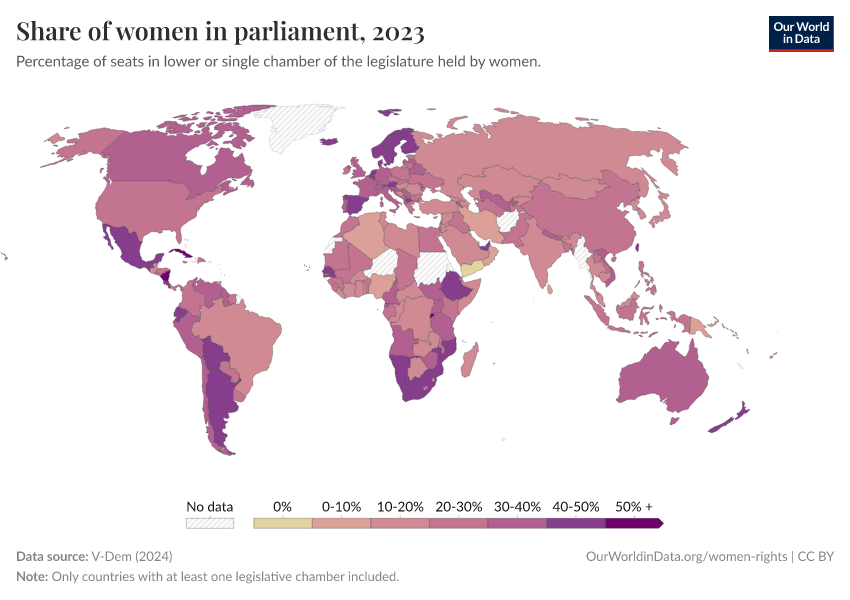
SDG Indicator 5.5.2Women in managerial positions
Definition of the SDG indicator: Indicator 5.5.2 is the “proportion of women in managerial positions” in the UN SDG framework.
Data for this indicator is shown in the interactive visualizations as the share of middle or senior management positions filled by a woman (first chart). The second chart shows a related measure, percentage of firms with a woman as the top manager.
Target: By 2030 “ensure women’s full and effective participation and equal opportunities for leadership at all levels of decision-making in political, economic and public life.”
More research: Further data and research on this topic can be found at the Our World in Data topic page on Women’s Rights and Women's Employment.
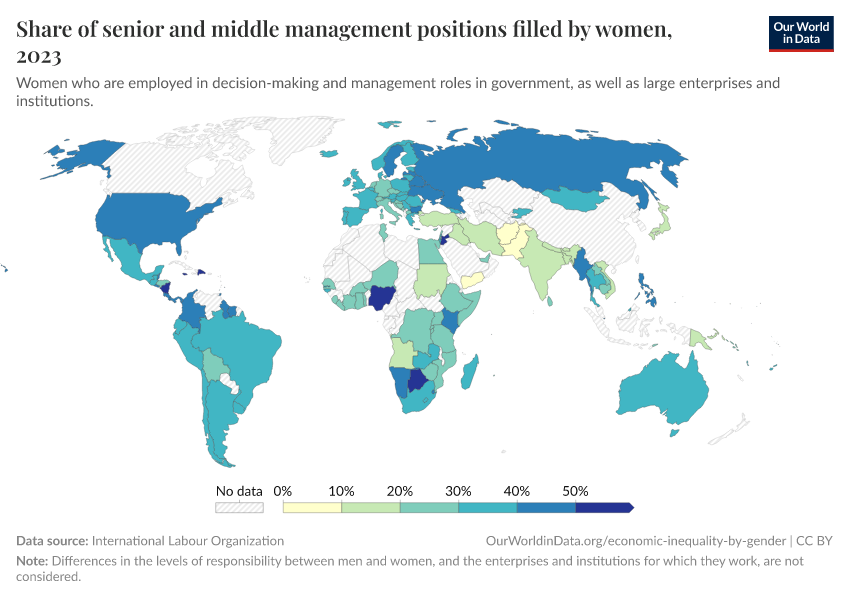
Target 5.6Universal access to reproductive rights and health
SDG Indicator 5.6.1Women decision-making on contraceptive use and healthcare
Definition of the SDG indicator: Indicator 5.6.1 is the “proportion of women aged 15–49 years who make their own informed decisions regarding sexual relations, contraceptive use and reproductive health care” in the UN SDG framework.
This is shown here as the percentage of women aged 15-49 years old that are married or in union who make their own informed decisions regarding sexual relations and reproductive healthcare.
Only women who answer "yes" to the following three conditions are considered to make their own informed decisions: can say no to sexual intercourse with their husband or partner if they do not want; decide on use of contraception; and decide on their own healthcare.
Data for this indicator is shown in the interactive visualization.
Target: By 2030 “ensure universal access to sexual and reproductive health and reproductive rights.” 3
More research: Further data and research on this topic can be found at the Our World in Data topic page on Women’s Rights.

SDG Indicator 5.6.2Guarantee of equal access to sexual and reproductive health care
Definition of the SDG indicator: Indicator 5.6.2 is the “number of countries with laws and regulations that guarantee full and equal access to women and men aged 15 years and older to sexual and reproductive health care, information and education” in the UN SDG framework.
The interactive visualization shows the extent to which a given country has laws and regulations that guarantee full and equal access to women and men aged 15 years and older to sexual and reproductive health care, information and education. The score for each country is calculated based on 13 components, including access to maternity care and contraception. This measure focuses only on the presence of laws and regulations, not the extent of their implementation.
Data for this indicator is shown in the interactive visualization.
Target: By 2030 “ensure universal access to sexual and reproductive health and reproductive rights.” 3
More research: Further data and research on this topic can be found at the Our World in Data topic page on Women’s Rights and Global Health.

Target 5.aEqual rights to economic resources, property ownership and financial services
SDG Indicator 5.a.1Female land rights or ownership
Definition of the SDG indicator: Indicator 5.a.1 is the “(a) proportion of total agricultural population with ownership or secure rights over agricultural land, by sex; and (b) share of women among owners or rights-bearers of agricultural land, by type of tenure” in the UN SDG framework.
Data for this indicator is shown in the interactive visualizations. Data for indicator 5.a.1(a) is shown in the first chart, and data for indicator 5.a.1(b) is shown in the second chart.
Target: By 2030 “undertake reforms to give women equal rights to economic resources, as well as access to ownership and control over land and other forms of property.”4
More research: Further data and research on this topic can be found at the Our World in Data topic pages on Women’s Rights and Economic Inequality by Gender.
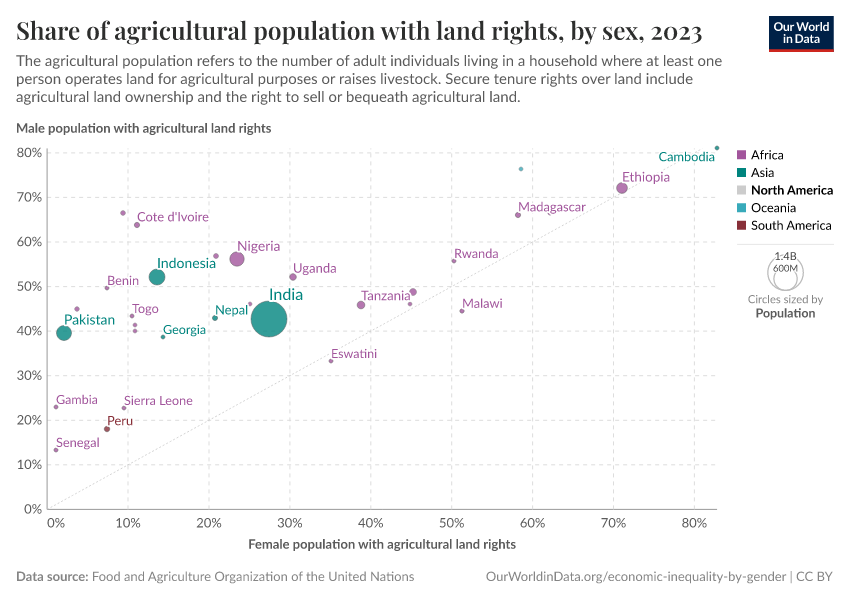
SDG Indicator 5.a.2Equal rights to land ownership
Definition of the SDG indicator: Indicator 5.a.2 is the “proportion of countries where the legal framework (including customary law) guarantees women’s equal rights to land ownership and/or control” in the UN SDG framework.
This is measured on the basis of whether a given country's legal framework guarantees women's equal rights to land ownership. Data for this indicator is shown in the first chart in the interactive visualizations, along with a related measure for land ownership differences between men and women (second chart).
Target: By 2030 “undertake reforms to give women equal rights to economic resources, as well as access to ownership and control over land and other forms of property.”4
More research: Further data and research on this topic can be found at the Our World in Data topic pages on Women’s Rights and Economic Inequality by Gender.

Target 5.bPromote empowerment of women through technology
SDG Indicator 5.b.1Mobile telephone ownership
Definition of the SDG indicator: Indicator 5.b.1 is the “proportion of individuals who own a mobile telephone, by sex” in the UN SDG framework.
Data for this indicator is shown as the share of women and men who own a mobile telephone.
Target: By 2030 “enhance the use of enabling technology, in particular information and communications technology, to promote the empowerment of women.”
There is no defined target level for this indicator.
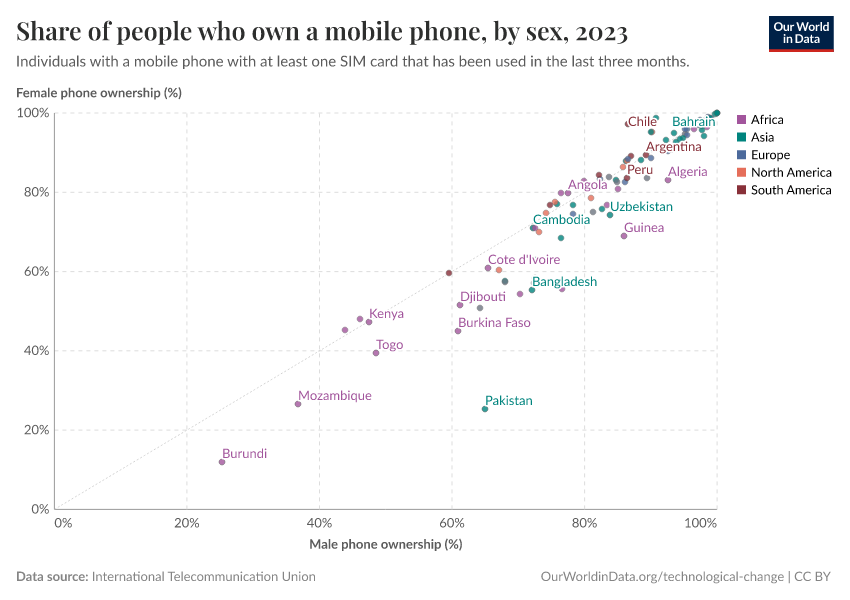
Target 5.cAdopt and strengthen policies and enforceable legislation for gender equality
SDG Indicator 5.c.1Systems to track gender equality
Definition of the SDG indicator: Indicator 5.c.1 is the “proportion of countries with systems to track and make public allocations for gender equality and women’s empowerment” in the UN SDG framework.
This indicator is measured as whether a given country has systems in place to track and make publicly available information about budget allocations for gender equality and women’s empowerment. This definition does not reflect the extent or quality of spending on gender equality and women’s empowerment programs.
Data for this indicator is shown in the interactive visualization.
Target: By 2030 “adopt and strengthen sound policies and enforceable legislation for the promotion of gender equality.”5
More research: Further data and research on this topic can be found at the Our World in Data topic page on Women’s Rights.

Endnotes
Full text: “Eliminate all forms of violence against all women and girls in the public and private spheres, including trafficking and sexual and other types of exploitation.”
Full text: “Recognize and value unpaid care and domestic work through the provision of public services, infrastructure and social protection policies and the promotion of shared responsibility within the household and the family as nationally appropriate.”
Full text: “Ensure universal access to sexual and reproductive health and reproductive rights as agreed in accordance with the Programme of Action of the International Conference on Population and Development and the Beijing Platform for Action and the outcome documents of their review conferences”
Full text: “Undertake reforms to give women equal rights to economic resources, as well as access to ownership and control over land and other forms of property, financial services, inheritance and natural resources, in accordance with national laws.”
Full text:”Adopt and strengthen sound policies and enforceable legislation for the promotion of gender equality and the empowerment of all women and girls at all levels.”
Cite this work
Our articles and data visualizations rely on work from many different people and organizations. When citing this article, please also cite the underlying data sources. This article can be cited as:
Our World in Data team (2023) - “Achieve gender equality and empower all women and girls” Published online at OurWorldinData.org. Retrieved from: 'https://archive.ourworldindata.org/20251220-152415/sdgs/gender-equality.html' [Online Resource] (archived on December 20, 2025).BibTeX citation
@article{owid-sdgs-gender-equality,
author = {Our World in Data team},
title = {Achieve gender equality and empower all women and girls},
journal = {Our World in Data},
year = {2023},
note = {https://archive.ourworldindata.org/20251220-152415/sdgs/gender-equality.html}
}Reuse this work freely
All visualizations, data, and code produced by Our World in Data are completely open access under the Creative Commons BY license. You have the permission to use, distribute, and reproduce these in any medium, provided the source and authors are credited.
The data produced by third parties and made available by Our World in Data is subject to the license terms from the original third-party authors. We will always indicate the original source of the data in our documentation, so you should always check the license of any such third-party data before use and redistribution.
All of our charts can be embedded in any site.